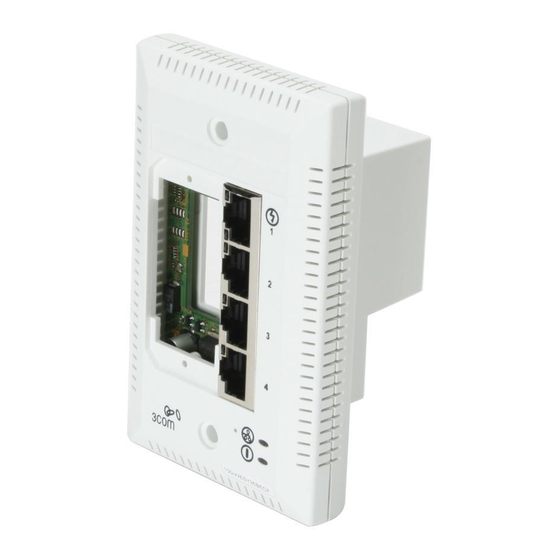3Com IntelliJack NJ200 Manuel complémentaire - Page 8
Parcourez en ligne ou téléchargez le pdf Manuel complémentaire pour {nom_de_la_catégorie} 3Com IntelliJack NJ200. 3Com IntelliJack NJ200 14 pages. Network jacks
Également pour 3Com IntelliJack NJ200 : Manuel du logiciel (7 pages), Fiche technique (4 pages)

3 C O M
®
N J 2 0 0 N E T W O R K J A C K — V L A N S & T R A F F I C P R I O R I T I Z AT I O N
What is Traffic Prioritization?
8
IEEE 802.1D/D17 (which incorporates IEEE 802.1p) traffic prioritization lets IT staff
establish packet-based control over network traffic. These advanced features allow high-
priority packets containing time-sensitive or system-critical data to be transmitted with
minimal delay.
Traffic prioritization can also help differentiate network traffic by type—such as multi-
media, video, protocol-specific, time critical, and file-backup.
Benefits
Traffic prioritization can significantly reduce bandwidth limitations, network delay,
data loss, and jitter (interference). Traffic prioritization is most useful for critical appli-
cations that require a high Class of Service (CoS) from the network.
In addition to delivering the above capabilities, the NJ200 Network Jack can help
increase the reliability of data delivery, allow specific applications to be prioritized
across the network, and define exactly how to treat selected applications and types of
traffic. The following are a few of the many applications that can benefit from being
connected through this standard-compliant switch:
Converged network applications
physical infrastructure. These sophisticated applications require maximum bandwidth
and minimal latency in order to deliver high-quality voice and video transmissions.
Resource planning applications
access to core enterprise servers such as SAP.
Financial applications
are used by accounting departments to handle AR/AP, taxes,
interest payments, and other business-critical processes. These powerful programs need
immediate and reliable access to large datasets and bulky spreadsheets.
CAD/CAM design applications
accessing server farms and transferring very large graphics files.
How Traffic Prioritization Works
IEEE 802.1D/p traffic prioritization differentiates data packets into classes that are used
to automatically select and forward high-priority transmissions over less critical traffic.
This helps ensure that time-sensitive and business-critical communications get the high-
est level of service. Traffic prioritization also separates the queuing of time-critical
frames to help reduce jitter.
Table 3 shows the range of priority tag values, with 7 having the highest importance
and 1 the lowest.
Note: The NJ200 Network Jack default priority tag setting is 0. This has a higher priority than 2, which is
used for nonessential traffic.
Table 3. IEEE 802.1D/p Traffic Prioritization Tag Values
Value
Tag
0
Best Effort
1
Background
2
Standard
3
Excellent Effort
4
Controlled Load
5
Video
6
Voice
7
Network Control
The 802.1D/p-compliant switch gives preference to Ethernet frames with higher prior-
ity tag values. High-priority traffic is directed through hardware-based queues that are
kept separate from queues for lower priority traffic.
enable voice, video, and data traffic to share the same
rely on time-sensitive communications and on-demand
take up enormous amounts of network bandwidth—for
Traffic Type
Default setting
Background system processes
Spare, nonessential
Business-critical
Streaming multimedia
Interactive media; latency <100 ms; jitter-control queuing
Interactive voice; latency <10 ms; jitter-control queuing
Reserved network processes
